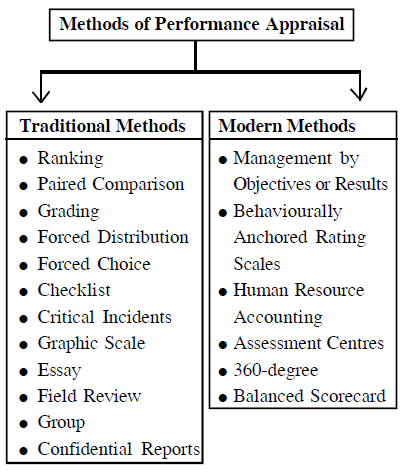UGC NET COMMERCE November 2017(Paper-II) Q40
| List-I | List-II |
| (a) Paired comparison method | (i) Reviewing employee records and holding interview on definite test questions. |
| (b) Forced choice description method | (ii) Set of pair phrases or descriptive statements |
| (c) Critical Incidents method | (iii) Differentiating between effective and non-effective performance on basis of achievements |
| (d) Field review method | (iv) Relative ranking method |
CODES
| (a) | (b) | (c) | (d) | |
| 1 | (iv) | (ii) | (iii) | (i) |
| 2 | (ii) | (iii) | (iv) | (i) |
| 3 | (iii) | (i) | (iv) | (ii) |
| 4 | (ii) | (iv) | (i) | (iii) |
- Option : A
- Explanation : Methods of Performance Appraisal: There are various methods of performance appraisal depending on the size and nature of the organization. Broadly speaking, the methods of performance appraisal may be divided into two–Traditional Methods and Modern Methods.

Traditional Methods
1. Ranking Method: Under this method an employee is ranked against others on the basis of certain traits and characteristics from best to worst. This method is very simple and inexpensive. But its reliability and validity may be open to doubt.
2. Paired Comparison Method: Under this method, each employee is compared with other employees taking only one at a time, usually on one trait. Where the number of employees are less, the number of comparisons required can be deducted by the formulae N(N –1)/2.
3. Grading Method: Under this method, different grades of performance are determined in advance such as excellent, very good, good, satisfactory and poor. Employees are placed in any of these grades according to their performance.
4. Forced Distribution Method: Under this method, the employees are appraised according to the pattern of a normal curve (bell shaped) in order to check tendency of appraisers to rate most of the employees around high points. This method forces the appraisers to spread their employee evaluations in a prescribed distribution. The distribution in general is as under:
20% of employees = excellent performers
60% of employees = average performers
20% of employees = poor performers
This method is based on questionable assumption that all groups of employees will have the same distribution of excellent, average and poor performance.
5. Forced Choice Method: Under this method, a series of group of statements are given and the appraiser checks how well the statement describes each individual employee being evaluated. Such statements may be both positive and negative. This method does not reveal as to which statement will be considered for final rating and therefore checks rater subjectivity. This method poses lot of problem in framing statements.
6. Checklist Method: Under this method, a list of statements or words are given and the appraiser is asked to check statements representing the characteristics and performance of each employee. The statements may carry yes/no alternative or + and – sign representing possession or non-possession of required characteristics and performance. This method poses a lot of difficulty in assembling, analyzing and weighing a number of statements about employee characteristics and contributions.
7. Critical Incidents Method: Under this method, the appraiser continuously records the critical incidents of the employee performance or behaviour relating to all characteristics both positive and negative in a specially designed notebook. A group of experts then assigns values to them depending on the degree of desirability for the job. This method requires rater to continuously record critical incidents which the rate may resent.
8. Graphic Scale Method: Under this method, employee characteristics and performance are evaluated through a graph. Following characteristics are included such as: quantity of work, quality of work, attentiveness, initiative, leadership, health and hygiene, safety habits, planning and organizing skills, analytical skills, innovation and creativity, etc. The rate estimates the degree to which each quality is possessed by the employee on a predefined scale, which normally varies from 3 to 7 points.
9. Essay Method: Under this method, rater assesses the employee performance on certain parameters in his own words by giving specific examples of employee behaviour. This time and effort involved in writing separate essays for all the employees can be a formidable and daunting task.


